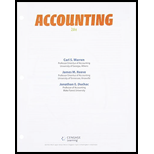
Ethical Case Study
Case Summary:
Dr. B and Dr. R are sole owners of two medical practices that operate in the same medical building. The two doctors agree to combine assets and liabilities of the two businesses to form a
To discuss: If Dr. R is acting in ethical manner and how Dr. B can renegotiate the partnership agreement to avoid the dispute?
Want to see the full answer?
Check out a sample textbook solution
Chapter 12 Solutions
Bundle: Accounting, Loose-Leaf Version, 26th + CengageNOWv2, 2 term Printed Access Card
- Hi teacher please provide for General accounting question answer do fastarrow_forwardWhat was net capital spending?arrow_forwardHardy Technologies reports that at an activity level of 6,800 machine-hours in a month, its total variable inspection cost is $320,000 and its total fixed inspection cost is $150,000. What would be the average fixed inspection cost per unit at an activity level of 7,100 machine-hours in a month? Assume that this level of activity is within the relevant range. (a) $21.13 (b) $23.50 (c) $20.00 (d) $19.45arrow_forward
 College Accounting, Chapters 1-27 (New in Account...AccountingISBN:9781305666160Author:James A. Heintz, Robert W. ParryPublisher:Cengage Learning
College Accounting, Chapters 1-27 (New in Account...AccountingISBN:9781305666160Author:James A. Heintz, Robert W. ParryPublisher:Cengage Learning Individual Income TaxesAccountingISBN:9780357109731Author:HoffmanPublisher:CENGAGE LEARNING - CONSIGNMENT
Individual Income TaxesAccountingISBN:9780357109731Author:HoffmanPublisher:CENGAGE LEARNING - CONSIGNMENT Cornerstones of Cost Management (Cornerstones Ser...AccountingISBN:9781305970663Author:Don R. Hansen, Maryanne M. MowenPublisher:Cengage Learning
Cornerstones of Cost Management (Cornerstones Ser...AccountingISBN:9781305970663Author:Don R. Hansen, Maryanne M. MowenPublisher:Cengage Learning





